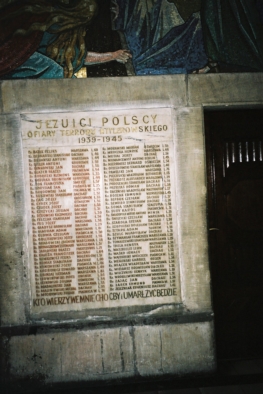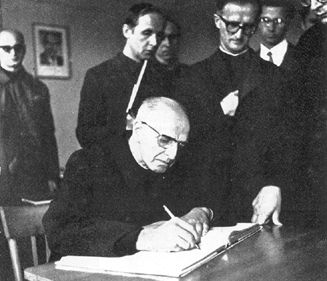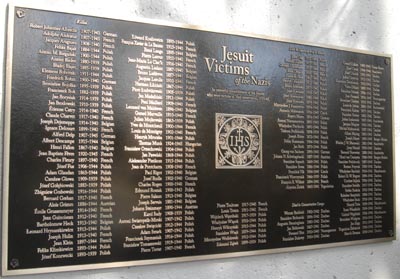
152 Jesuit Victims of the Nazis
***
Jesuits Killed During the Holocaust - 82 Victims
Jesuits who Died in Concentration Camps - 43 Victims
Jesuits who Died in Captivity or of its Results - 27 Victims
-- From The
Jesuits and the Third Reich
by Vincent A. Lapomarda.
THE ABOVE 55 BY 28 PLAQUE IN BRONZE OF THE JESUIT VICTIMS OF
THE NAZIS WAS DEDICATED AT THE FINUCANE JESUIT CENTER OF ROCKHURST
JESUIT UNIVERSITY
IN KANSAS CITY, MISSOURI, ON APRIL 12, 2007. IT WAS FUNDED
BY ELIOT BERKELEY, A ROCKHURST REGENT, AND HIS WIFE MARCIA. THE 152
NAMES ARE FROM
VINCENT A. LAPOMARDA'S BOOK, THE JESUITS AND THE THIRD REICH.
CLICK ON THE PICTURE TO READ THE NAMES OF THE VICTIMS.
BASILICA OF THE SACRED HEART
KRAKOW, POLAND

PLAQUE OF POLISH JESUITS WHO WERE
VICTIMS OF THE NAZIS
___
***


Very Rev. Pedro Arrupe (1907-1991), Superior General of the Society
of Jesus (1965-81), signing the Guest Book at the Majdanek, the major concentration
camp in area of Lublin, Poland, where at least three Jesuit priests (Kazimierz
Maciejewski, Stefan Sliwinski, and Jozef Warszawski) and one Jesuit brother
(Marcin Malik) were imprisoned during World War II. This Picture
was published in Ojczyzna (1969).

Father
Adam Sztark and Companions, Jesuit Martyrs:
(Their Cause was inaugurated, on March 23, 2000; the Vatican
Congregation approved, on May 15, 2003,the request of the Polish Bishops
Conference to open the Canonization Process; and the first sessionof the
Canonization Process took place on September 17, 2003. On the 4th November
2004, in a solemn ceremony, Joseph Cardinal Glemp brought to a close the
informatory process of nine Jesuit servants of God, who belonged to the
Jesuit Province of Greater Poland and Masovia, martyrs of the II WW (they
are indicated with a cross below). The Jesuits of the Province
of Minor Poland are conducting their own informatory process on the eight
other Jesuit martyrs.)
Fr.
Stanislaw Bednarski (1902-1942) at Dachau
Fr. Jozef Cyrek (1904-1940) at Auschwitz
Fr. Kazimierz Dembowski (1912-1942) at Dachau
Fr. Stanislaw Felczak (1906-1942) at Dachau+
Fr. Franciszek Kaluza (1877-1941) at Dachau
Br. Stanislaw Komar (1882-1942) at Dachau+
Fr. Michal Malinowski (1887-1942) at Dachau+
Fr. Marian Jozef Wojciech Morawski (1881-1940) at Auschwitz+
Mr. Jerzy Musial (1919-1945) at Dachau+
Fr. Stanislaw Tadeusz Podolenski (1887-1945) at Dachau
Fr. Edmund Roszak (1900-1943) at Swislocz+
Fr. Czeslaw Sejbuk (1906-1943) at Dachau+
Mr. Stanislaw Sewillo (1907-1943) at Dachau
Fr. Adam
Sztark (1907-1942) at Slonim+
Fr. Wladyslaw Wiacek (1910-1944) at Warsaw+
Mr. Bronislaw Wielgosz (1916-1942) at Dachau
Br. Jan Zajac (1911-1945) at Dachau
***

ADAM
SZTARK, S. J. (1907-1942)
MARTYR
